Mengping Yang
Uni-cot: Towards Unified Chain-of-Thought Reasoning Across Text and Vision
Aug 07, 2025
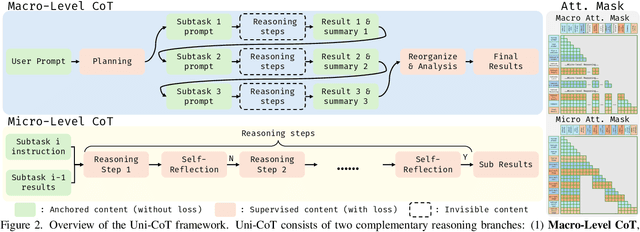

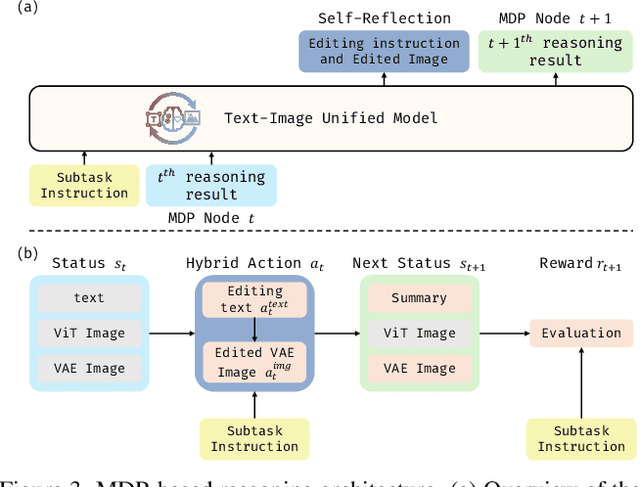
Abstract:Chain-of-Thought (CoT) reasoning has been widely adopted to enhance Large Language Models (LLMs) by decomposing complex tasks into simpler, sequential subtasks. However, extending CoT to vision-language reasoning tasks remains challenging, as it often requires interpreting transitions of visual states to support reasoning. Existing methods often struggle with this due to limited capacity of modeling visual state transitions or incoherent visual trajectories caused by fragmented architectures. To overcome these limitations, we propose Uni-CoT, a Unified Chain-of-Thought framework that enables coherent and grounded multimodal reasoning within a single unified model. The key idea is to leverage a model capable of both image understanding and generation to reason over visual content and model evolving visual states. However, empowering a unified model to achieve that is non-trivial, given the high computational cost and the burden of training. To address this, Uni-CoT introduces a novel two-level reasoning paradigm: A Macro-Level CoT for high-level task planning and A Micro-Level CoT for subtask execution. This design significantly reduces the computational overhead. Furthermore, we introduce a structured training paradigm that combines interleaved image-text supervision for macro-level CoT with multi-task objectives for micro-level CoT. Together, these innovations allow Uni-CoT to perform scalable and coherent multi-modal reasoning. Furthermore, thanks to our design, all experiments can be efficiently completed using only 8 A100 GPUs with 80GB VRAM each. Experimental results on reasoning-driven image generation benchmark (WISE) and editing benchmarks (RISE and KRIS) indicates that Uni-CoT demonstrates SOTA performance and strong generalization, establishing Uni-CoT as a promising solution for multi-modal reasoning. Project Page and Code: https://sais-fuxi.github.io/projects/uni-cot/
Omni-Video: Democratizing Unified Video Understanding and Generation
Jul 09, 2025Abstract:Notable breakthroughs in unified understanding and generation modeling have led to remarkable advancements in image understanding, reasoning, production and editing, yet current foundational models predominantly focus on processing images, creating a gap in the development of unified models for video understanding and generation. This report presents Omni-Video, an efficient and effective unified framework for video understanding, generation, as well as instruction-based editing. Our key insight is to teach existing multimodal large language models (MLLMs) to produce continuous visual clues that are used as the input of diffusion decoders, which produce high-quality videos conditioned on these visual clues. To fully unlock the potential of our system for unified video modeling, we integrate several technical improvements: 1) a lightweight architectural design that respectively attaches a vision head on the top of MLLMs and a adapter before the input of diffusion decoders, the former produce visual tokens for the latter, which adapts these visual tokens to the conditional space of diffusion decoders; and 2) an efficient multi-stage training scheme that facilitates a fast connection between MLLMs and diffusion decoders with limited data and computational resources. We empirically demonstrate that our model exhibits satisfactory generalization abilities across video generation, editing and understanding tasks.
Cockatiel: Ensembling Synthetic and Human Preferenced Training for Detailed Video Caption
Mar 12, 2025Abstract:Video Detailed Captioning (VDC) is a crucial task for vision-language bridging, enabling fine-grained descriptions of complex video content. In this paper, we first comprehensively benchmark current state-of-the-art approaches and systematically identified two critical limitations: biased capability towards specific captioning aspect and misalignment with human preferences. To address these deficiencies, we propose Cockatiel, a novel three-stage training pipeline that ensembles synthetic and human-aligned training for improving VDC performance. In the first stage, we derive a scorer from a meticulously annotated dataset to select synthetic captions high-performing on certain fine-grained video-caption alignment and human-preferred while disregarding others. Then, we train Cockatiel-13B, using this curated dataset to infuse it with assembled model strengths and human preferences. Finally, we further distill Cockatiel-8B from Cockatiel-13B for the ease of usage. Extensive quantitative and qualitative experiments reflect the effectiveness of our method, as we not only set new state-of-the-art performance on VDCSCORE in a dimension-balanced way but also surpass leading alternatives on human preference by a large margin as depicted by the human evaluation results.
Adversarial Semantic Augmentation for Training Generative Adversarial Networks under Limited Data
Feb 02, 2025Abstract:Generative adversarial networks (GANs) have made remarkable achievements in synthesizing images in recent years. Typically, training GANs requires massive data, and the performance of GANs deteriorates significantly when training data is limited. To improve the synthesis performance of GANs in low-data regimes, existing approaches use various data augmentation techniques to enlarge the training sets. However, it is identified that these augmentation techniques may leak or even alter the data distribution. To remedy this, we propose an adversarial semantic augmentation (ASA) technique to enlarge the training data at the semantic level instead of the image level. Concretely, considering semantic features usually encode informative information of images, we estimate the covariance matrices of semantic features for both real and generated images to find meaningful transformation directions. Such directions translate original features to another semantic representation, e.g., changing the backgrounds or expressions of the human face dataset. Moreover, we derive an upper bound of the expected adversarial loss. By optimizing the upper bound, our semantic augmentation is implicitly achieved. Such design avoids redundant sampling of the augmented features and introduces negligible computation overhead, making our approach computation efficient. Extensive experiments on both few-shot and large-scale datasets demonstrate that our method consistently improve the synthesis quality under various data regimes, and further visualized and analytic results suggesting satisfactory versatility of our proposed method.
E2EDiff: Direct Mapping from Noise to Data for Enhanced Diffusion Models
Dec 30, 2024



Abstract:Diffusion models have emerged as a powerful framework for generative modeling, achieving state-of-the-art performance across various tasks. However, they face several inherent limitations, including a training-sampling gap, information leakage in the progressive noising process, and the inability to incorporate advanced loss functions like perceptual and adversarial losses during training. To address these challenges, we propose an innovative end-to-end training framework that aligns the training and sampling processes by directly optimizing the final reconstruction output. Our method eliminates the training-sampling gap, mitigates information leakage by treating the training process as a direct mapping from pure noise to the target data distribution, and enables the integration of perceptual and adversarial losses into the objective. Extensive experiments on benchmarks such as COCO30K and HW30K demonstrate that our approach consistently outperforms traditional diffusion models, achieving superior results in terms of FID and CLIP score, even with reduced sampling steps. These findings highlight the potential of end-to-end training to advance diffusion-based generative models toward more robust and efficient solutions.
EVALALIGN: Supervised Fine-Tuning Multimodal LLMs with Human-Aligned Data for Evaluating Text-to-Image Models
Jun 27, 2024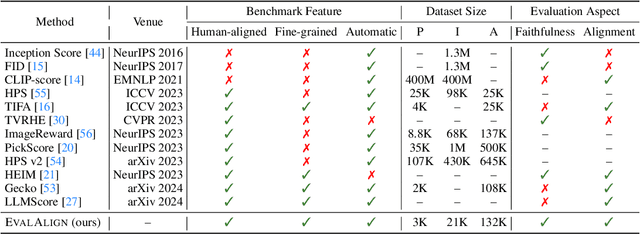
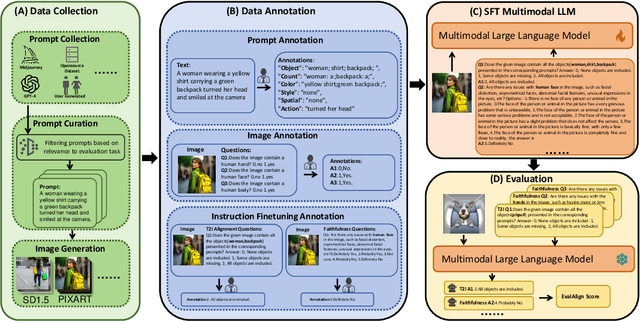
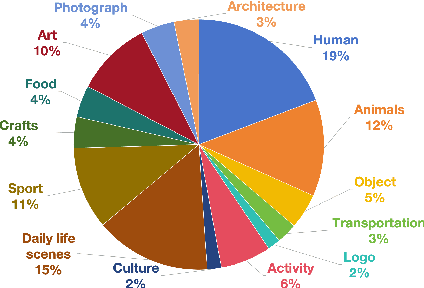
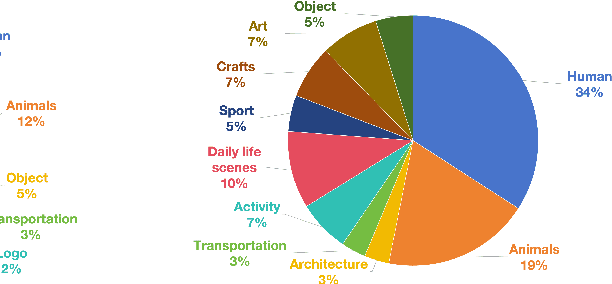
Abstract:The recent advancements in text-to-image generative models have been remarkable. Yet, the field suffers from a lack of evaluation metrics that accurately reflect the performance of these models, particularly lacking fine-grained metrics that can guide the optimization of the models. In this paper, we propose EvalAlign, a metric characterized by its accuracy, stability, and fine granularity. Our approach leverages the capabilities of Multimodal Large Language Models (MLLMs) pre-trained on extensive datasets. We develop evaluation protocols that focus on two key dimensions: image faithfulness and text-image alignment. Each protocol comprises a set of detailed, fine-grained instructions linked to specific scoring options, enabling precise manual scoring of the generated images. We Supervised Fine-Tune (SFT) the MLLM to align closely with human evaluative judgments, resulting in a robust evaluation model. Our comprehensive tests across 24 text-to-image generation models demonstrate that EvalAlign not only provides superior metric stability but also aligns more closely with human preferences than existing metrics, confirming its effectiveness and utility in model assessment.
EvalAlign: Evaluating Text-to-Image Models through Precision Alignment of Multimodal Large Models with Supervised Fine-Tuning to Human Annotations
Jun 24, 2024



Abstract:The recent advancements in text-to-image generative models have been remarkable. Yet, the field suffers from a lack of evaluation metrics that accurately reflect the performance of these models, particularly lacking fine-grained metrics that can guide the optimization of the models. In this paper, we propose EvalAlign, a metric characterized by its accuracy, stability, and fine granularity. Our approach leverages the capabilities of Multimodal Large Language Models (MLLMs) pre-trained on extensive datasets. We develop evaluation protocols that focus on two key dimensions: image faithfulness and text-image alignment. Each protocol comprises a set of detailed, fine-grained instructions linked to specific scoring options, enabling precise manual scoring of the generated images. We Supervised Fine-Tune (SFT) the MLLM to align closely with human evaluative judgments, resulting in a robust evaluation model. Our comprehensive tests across 24 text-to-image generation models demonstrate that EvalAlign not only provides superior metric stability but also aligns more closely with human preferences than existing metrics, confirming its effectiveness and utility in model assessment.
Attention Calibration for Disentangled Text-to-Image Personalization
Apr 11, 2024Abstract:Recent thrilling progress in large-scale text-to-image (T2I) models has unlocked unprecedented synthesis quality of AI-generated content (AIGC) including image generation, 3D and video composition. Further, personalized techniques enable appealing customized production of a novel concept given only several images as reference. However, an intriguing problem persists: Is it possible to capture multiple, novel concepts from one single reference image? In this paper, we identify that existing approaches fail to preserve visual consistency with the reference image and eliminate cross-influence from concepts. To alleviate this, we propose an attention calibration mechanism to improve the concept-level understanding of the T2I model. Specifically, we first introduce new learnable modifiers bound with classes to capture attributes of multiple concepts. Then, the classes are separated and strengthened following the activation of the cross-attention operation, ensuring comprehensive and self-contained concepts. Additionally, we suppress the attention activation of different classes to mitigate mutual influence among concepts. Together, our proposed method, dubbed DisenDiff, can learn disentangled multiple concepts from one single image and produce novel customized images with learned concepts. We demonstrate that our method outperforms the current state of the art in both qualitative and quantitative evaluations. More importantly, our proposed techniques are compatible with LoRA and inpainting pipelines, enabling more interactive experiences.
Improving Few-shot Image Generation by Structural Discrimination and Textural Modulation
Aug 30, 2023


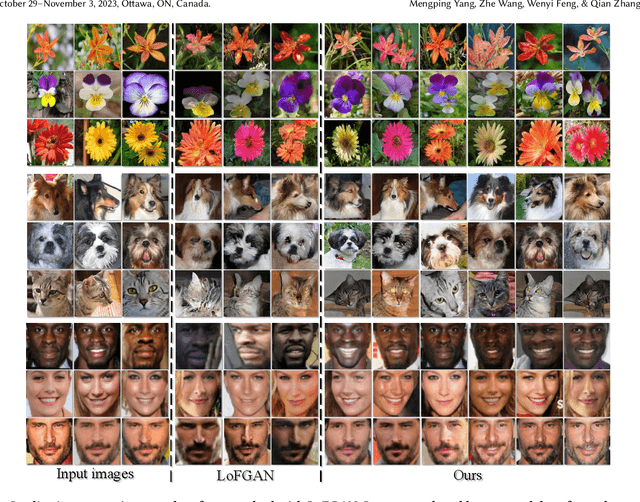
Abstract:Few-shot image generation, which aims to produce plausible and diverse images for one category given a few images from this category, has drawn extensive attention. Existing approaches either globally interpolate different images or fuse local representations with pre-defined coefficients. However, such an intuitive combination of images/features only exploits the most relevant information for generation, leading to poor diversity and coarse-grained semantic fusion. To remedy this, this paper proposes a novel textural modulation (TexMod) mechanism to inject external semantic signals into internal local representations. Parameterized by the feedback from the discriminator, our TexMod enables more fined-grained semantic injection while maintaining the synthesis fidelity. Moreover, a global structural discriminator (StructD) is developed to explicitly guide the model to generate images with reasonable layout and outline. Furthermore, the frequency awareness of the model is reinforced by encouraging the model to distinguish frequency signals. Together with these techniques, we build a novel and effective model for few-shot image generation. The effectiveness of our model is identified by extensive experiments on three popular datasets and various settings. Besides achieving state-of-the-art synthesis performance on these datasets, our proposed techniques could be seamlessly integrated into existing models for a further performance boost.
Image Synthesis under Limited Data: A Survey and Taxonomy
Jul 31, 2023



Abstract:Deep generative models, which target reproducing the given data distribution to produce novel samples, have made unprecedented advancements in recent years. Their technical breakthroughs have enabled unparalleled quality in the synthesis of visual content. However, one critical prerequisite for their tremendous success is the availability of a sufficient number of training samples, which requires massive computation resources. When trained on limited data, generative models tend to suffer from severe performance deterioration due to overfitting and memorization. Accordingly, researchers have devoted considerable attention to develop novel models that are capable of generating plausible and diverse images from limited training data recently. Despite numerous efforts to enhance training stability and synthesis quality in the limited data scenarios, there is a lack of a systematic survey that provides 1) a clear problem definition, critical challenges, and taxonomy of various tasks; 2) an in-depth analysis on the pros, cons, and remain limitations of existing literature; as well as 3) a thorough discussion on the potential applications and future directions in the field of image synthesis under limited data. In order to fill this gap and provide a informative introduction to researchers who are new to this topic, this survey offers a comprehensive review and a novel taxonomy on the development of image synthesis under limited data. In particular, it covers the problem definition, requirements, main solutions, popular benchmarks, and remain challenges in a comprehensive and all-around manner.
 Add to Chrome
Add to Chrome Add to Firefox
Add to Firefox Add to Edge
Add to Edge